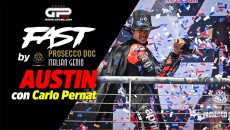MotoGP or Formula 1: which vehicle is faster? And which has better braking? The Austin circuit is the testing ground to help answer the question on the minds of every enthusiast.
The Texan track is in fact one of the two (the other being Sepang) to host a competition for the 2 and 4 wheel World Racing Championship on the same circuit (5,513 metres long). MotoGP will take to the Circuit of the Americas this weekend while Formula 1 will come to Texas on October 23 of this year. Backed by its experience as supplier of the leading teams of the two, Brembo is able to provide some extremely interesting information.
First however, let us give you the technical specifications of the two prototypes:
Excluding the drivers or riders, a Formula 1 vehicle weighs four times a MotoGP bike and boasts a much more powerful engine (also for the presence of electric motors). The tires are a whole different story: in comparison with a bike, Formula 1 single-seaters have more tires (4 instead of 2) and a more generous tread.
Furthermore, aside from tread width, the difference between F1 and MotoGP that counts is on the ground, meaning the contact surface of the tire with the asphalt which is extremely different due to the different make of car and bike tires. While in F1 the width of the tire coincides with the footprint on the ground, in MotoGp this is only a fraction of the total tread width.
Let's compare their performance over a lap at the Austin circuit in 2015:
Comparing the best lap during the 2015 competition obtained respectively by N. Rosberg and A. Iannone the gap between Formula 1 and MotoGP is somewhere around twenty seconds. Maximum speeds place MotoGP ahead of Formula 1.
The limits of MotoGP are essentially two:
1) The time required to reduce speed when facing a curve
2) Speed while in a curve
Both are attributable to several factors mainly including:
A) the different dynamics of the two vehicles, where MotoGP must take into account the tilt limit of the vehicle..
B) the substantial difference due to the aerodynamic load, non-existent on a MotoGP bike, but heavily influencing the deceleration values of an F1 car.
C) the significant difference of the footprint left by the tires of both vehicles.
To clarify point 1 let's refer to three situations derived from the data taken by Brembo in the past at Austin.
The braking speeds below, always at Austin, are representative of point 2:
Obviously, even bike braking distances are longer at Austin:
Not surprisingly, according to the Brembo engineers that assist the competitions in the field, at Austin riders of MotoGP spend 23 percent of the race braking while F1 drivers only 18 percent. A difference that determines significantly different lap times. The explanation is rather simple: the Formula 1 vehicles can immediately discharge the entire braking torque to the ground as they do not have issues with balance while MotoGP riders are forced to dose the force as the risk of flipping over a 2-wheel vehicle is high.
In addition, the single-seaters have a ground footprint of the four treads that is well over four times that of a MotoGP bike: naturally, the greater the footprint, the greater the opportunity to discharge the braking torque to the ground.
This is why the decelerations that the riders and drivers face are in line with the characteristics of the vehicles that they command.
The only aspect in common between the two categories at Austin is the effort required by the braking systems: Brembo engineers have classified both as medium difficulty.














